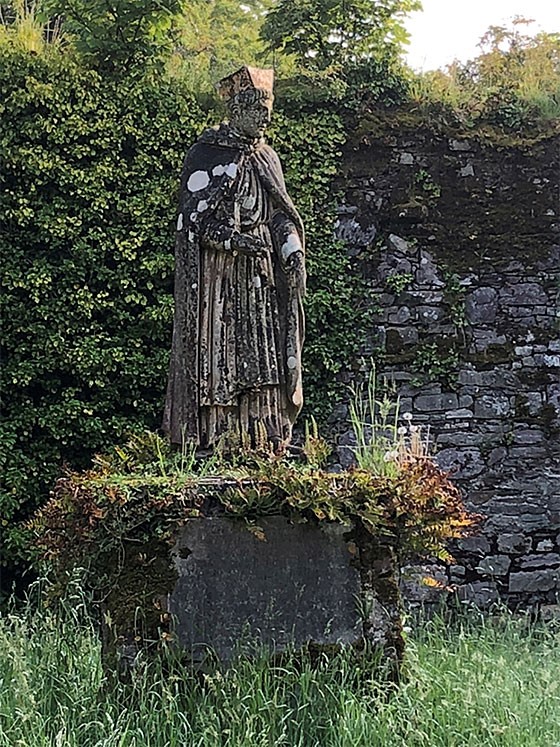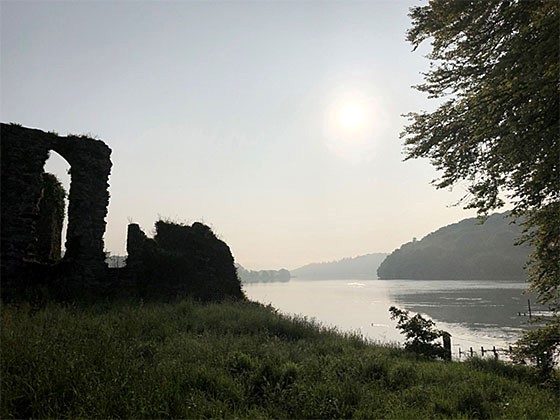YOUGHAL, IRELAND – What a beautiful time… to be in Ireland!
In the evening, the sun lingers in the sky, lighting up the millions of snowflake-like willow fluff.
Like cattails, they waft around on the breeze, so light that they scarcely feel the pull of gravity. Half go up while the other half go down.
Lured outside, as if by some Lorelei in the bushes, we left our keyboard yesterday evening and walked out towards the river.
The cottage we’ve rented while work continues on our new property nearby is on a big estate which sits at a bend in the Blackwater river, the big house looking directly onto the water… its back protected by a wide arc of hills.
“It is a stunning place… stunning…” we said to Elizabeth when we got back.
“And a very bad idea to take a walk on such a lovely evening…”
“Why is that?” she enquired.
“Because now, I want to buy the place…”
Restless and Reckless
We were letting our imagination run. Better to let it exhaust itself, we reasoned, than to try to pull it up short. Otherwise, it will grow restless… and reckless.
Yesterday’s path led us from our cottage down to the riverbank, where the earth had been diked up, creating a path from the main house to the ruins of an old abbey.
The main house is a very impressive and handsome Georgian edifice, built soon after the American Revolution.
This area had fairly close contact with the New World. In nearby Youghal, you can still see the house where Sir Walter Raleigh lived.
The adventurer brought back two things from his visit to Virginia – the potato and tobacco. Both were to have long-lasting consequences.
Our perambulation continued along the dike path. The river lay on our left. To our right was a large marsh. This left only the narrow causeway, easily defendable, from the mainland to the abbey.
We explored the ruins… stout stone walls still standing… covered with ivy…
 Bill discovers a neglected statue during his stroll
Bill discovers a neglected statue during his stroll
The abbey was founded in the 6th century by a disciple of St. Carthage, one of the earliest in Ireland.
Monks here kept a small flicker of civilization burning throughout the middle ages – despite being attacked by Vikings and plague (no records remain).
After the Norman invasion, the abbey came under the control of the Fitzgerald family and remained with the “Geraldines” until it was destroyed by English troops under Cromwell. It has been an ivy-covered ruin ever since, for nearly 400 years.
Gaudy Bloom
Looking across the river, we saw more ruins… a tower… and a church. We were tempted to lie down in the soft grass and contemplate the romantic beauty of the setting… of glories past… of monks diligently trying to preserve the wisdom and learning of the ancients… their cold hands copying the old documents… or working in the adjacent fields…
But our curiosity was aroused. Where did the path go next? What other wonders would it reveal?
The abbey stands on what was once an island… now connected by dikes and causeways leading along the riverbank in both directions. We had come from the West… we now continued along towards the East.
After leaving the dike, the path crosses the main entrance, with its large iron gate. Then, it takes you down a series of steps to the riverbank again.
There it continues… with rhododendron, azaleas, camellias, hawthorne, and wildflowers of unknown genus and species too numerous to mention… all in glorious, gaudy, late-May bloom.
Eventually, we discovered another set of steps leading to two abandoned gate houses. They flanked another entrance to the property, largely hidden from view. From there, a service road led us through field and forest back to our cottage.
Performing Assets
“It is a magnificent property,” we summarized for Elizabeth.
“Yes, but the last thing we need is another piece of property… and especially one that takes so much attention.”
Later, when we relayed this to our local man-on-the-scene, autodidact philosopher and weekend paddy sidekick, Ronan:
“Ah… that’s the problem… the upkeep.
“It’s all changed in my lifetime. It used to be that these big estates were ways to make money. They were productive. And profitable. And they had dozens of workers. They raised cattle and sheep. And tenant farmers paid rents. They were what you call on Wall Street ‘performing assets.’
“But now, the only performing they do is to put you in the poor house. Instead of providing an income… they cost you money. And over there… where you’re staying… that place must cost a fortune to maintain. I think they have five or six full-time employees over there. The owner tries to sell it from time to time, but who can afford it?
“It’s kind of funny for us little, local people, though. There was a time, not too long ago, when the lords of the manor had us waiting on them. We were at their beck and call, you might say. We doffed our caps when we saw them on the street… if we ever did… and we knew our place.
“But now, the owners are desperate to earn an income from these properties so they can pay the upkeep. The little people are living in their comfortable little houses in the suburbs of Dublin. And the lords and ladies are rattling around in their huge, cold, old houses… and with the roofs ready to fall in on them.
“So they take in tour groups… and weddings… and even host concerts and that sort of thing. And now, the lady of the manor greets a group of wage earners from Waterford or Cork… and she serves THEM tea!
“I guess that’s the way the world works. Sic transit gloria mundi. He that did ride so high doth lie so low… What goes around comes around… Or something like that.”
That was enough for us. We gave up our plan of buying the big estate and becoming the Lord of the Manor.
Immediately, we felt the weight lifted from our shoulders. The shackles were off our feet… and the noose was removed from around our neck.
“Well, you can pay millions of dollars for the privilege of worrying about how to make this work… and lose another couple hundred thousand a year maintaining it,” Elizabeth concluded. “Or we can pay $150 a night… and enjoy it all we want.
“And they’ll even make the bed.”
Regards,
![]()
Bill
Category: Economics


